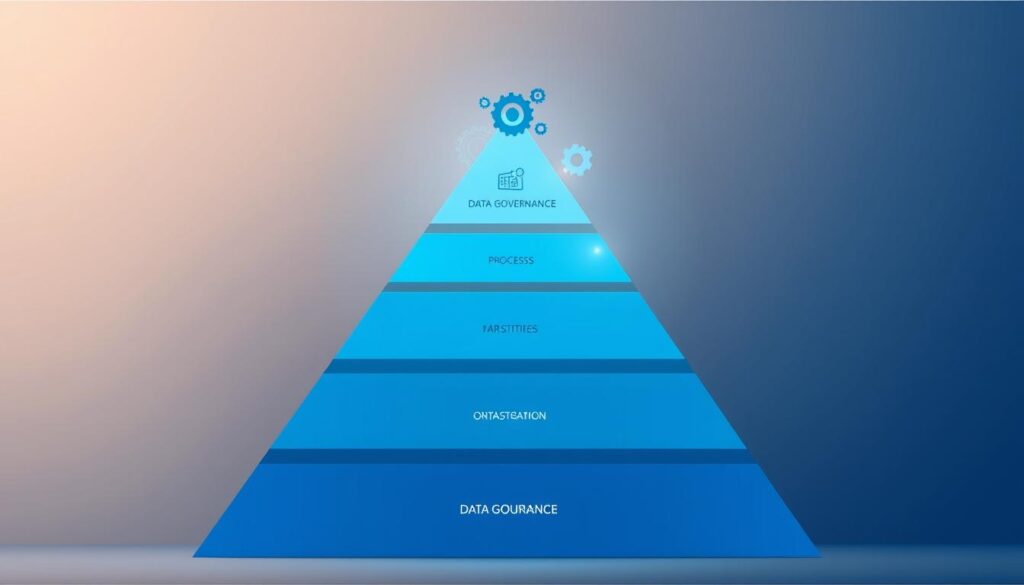I’ve worked in data analytics for a long time. I’ve seen how important good data management is for business success. Today, with more complex data, companies need strong data governance. This ensures their data is good, safe, and follows rules.
A McKinsey survey found 80% of companies have different data management ways in different parts. This shows the need for a single way to manage data. Our review aims to improve data management. We focus on master data management, data quality, and keeping data safe.
Good data governance can make data better, cut down on mistakes, and make things more efficient. For example, a data governance roadmap helps set a clear plan for managing data. Master data management is key to this. It helps make data better, less prone to errors, and more efficient.
Key Takeaways
- Effective data management is key for companies to stay ahead in today’s world.
- Data governance is vital for keeping data quality, security, and compliance high.
- Master data management is a big part of any data strategy.
- A good data governance plan can make data better, cut down on mistakes, and boost efficiency.
- Companies should track how well their data governance works. Use metrics like ROI and performance.
- It’s important to keep data stewards learning to ensure data governance success.
Understanding the Importance of Data Governance in Modern Business
Exploring data management, I see how vital Data Governance is for businesses today. With data growing fast, companies struggle to manage and use it well. A McKinsey study shows data volume doubles every two years, making Data Quality a big issue.
A good Data Strategy is key to using data to grow the business. Data Governance helps make smart choices, lowers risks, and boosts efficiency. Verizon found that PCI DSS compliance cuts cyber-attack risks by 50%, showing Data Governance‘s role in keeping data safe.
Having a solid Data Governance policy improves Data Quality, accuracy, and security. A skilled Data Governance leader ensures data is trustworthy and consistent. For more on Data Governance‘s role, check out this link.
- Improved decision-making
- Enhanced business planning and forecasting
- Improved financial performance
- Reduced organizational risk
- Increased efficiency
By focusing on Data Governance and a solid Data Strategy, businesses can fully use their data. This drives growth in today’s competitive market.
Our Data Governance Review Methodology
Reflecting on our data governance approach, I see that a detailed Data Governance Review is key. It helps organizations check and boost their Data Management skills. Our method ensures data and its rules are right and consistent, vital for good Master Data Management.
We dive deep into an organization’s data governance setup, quality, and management processes. We offer tips for bettering these areas, using top industry practices and our data governance know-how. This structured way helps firms create a steady plan for checking data definitions and making sure they meet their needs.
Our method covers important points like:
- Setting data governance goals and objectives
- Looking at the current state of data management
- Creating a plan for bettering it
- Tracking and managing progress
By using our method, companies can build a strong data governance system. This supports their Data Management strategy and helps with Master Data Management. This leads to smarter decisions, less operational trouble, and better data rule following.
Core Components of Effective Data Governance
Effective data governance is key for organizations to manage their data well. It involves several important parts. First, data quality assessment is vital to ensure data is correct and complete. Bad data quality can cause customer unhappiness and poor decisions.
Studies show 82% of people spend a lot of time fixing data quality issues. Data security is another big part. It protects sensitive data and follows rules. This is done through security and compliance frameworks, like encryption and access controls.
Metadata management helps understand data’s context and meaning. Data lifecycle management lets organizations manage data from start to end. These are key components of good data governance.
Some main parts of effective data governance are:
- Data quality metrics and benchmarks
- Security and compliance frameworks
- Metadata management strategies
- Data lifecycle management
By using these parts, organizations can make sure their data is right, safe, and follows rules. This leads to better decisions, more efficiency, and happier customers. So, good data governance is vital for success in today’s data world.
| Component | Description |
|---|---|
| Data Quality Metrics | Establishing benchmarks for data accuracy and completeness |
| Security and Compliance Frameworks | Implementing measures to protect sensitive data and ensure regulatory compliance |
| Metadata Management Strategies | Understanding the context and meaning of data |
| Data Lifecycle Management | Managing data throughout its entire lifecycle |
Measuring Data Governance Maturity
Organizations aim to better manage their data. To do this, they need to measure Data Governance Maturity. Our review includes a maturity assessment. It looks at the data governance framework, data quality, and management processes.
We use recognized frameworks and benchmarks for this assessment. This gives a clear view of what’s working well and what needs improvement.
Studies show that using a data governance maturity model helps improve data management. It boosts data quality, compliance, and aligns with business goals. For example, IBM has set up data governance councils and models to help others.
There are different levels of data governance maturity:
- Initial/Unaware: Organizations have unstructured data practices with a reactive approach or lack awareness of data governance.
- Managed/Aware: Organizations recognize the strategic significance of data with some structured processes or have leadership aligned on data governance vision.
- Defined/Proactive: Organizations have well-defined and consistent processes, incorporating data stewardship, and information governance is seen as key to improving decision-making and performance.

Measuring data governance maturity helps organizations see where they need to improve. It guides them to reach higher levels of data maturity. This improves decision-making and strategic alignment.
As Master Data Management becomes more important, prioritizing Data Governance Maturity is key. It ensures the value of data assets is maximized.
| Level | Description |
|---|---|
| Initial | Unstructured data practices with a reactive approach |
| Managed | Recognize strategic significance of data with some structured processes |
| Defined | Well-defined and consistent processes, incorporating data stewardship |
Implementation Roadmap and Best Practices
For Data Governance Implementation, a clear plan is key. First, check your Data Management setup and see where you can get better. Having a detailed data dictionary or metadata repository is vital. It acts as a central hub for all data, making it easy to find and use.
Planning and setting up resources are also important. You need a dedicated team for data governance, clear goals, and the right tools. Master Data Management helps keep data consistent and up-to-date across all systems and teams.
To make Data Governance work, involve everyone in planning and train your team well. This builds a culture that values data and ensures everyone knows their part in keeping data quality high. By doing this, you can make better decisions, save money, and improve your overall data management.
ROI and Business Impact Analysis
Exploring data governance shows how vital it is to measure its return on investment (ROI) and business impact. A detailed ROI and business impact analysis helps see the value of data governance for a company. It looks at the direct benefits, like cost cuts and revenue boosts, and the strategic gains, like better decision-making and efficiency.
Data governance can cut down on strategic mistakes by 20-30% thanks to more reliable data. It also speeds up decision-making by 15-25% with better data access. Cleaning and preparing data can be done 30-50% faster, making analytics work more efficient.
Some key advantages of data governance include:
- Cost savings from fewer data errors and penalties, up to 10-20% of operational costs
- Better analytics accuracy, with a possible up to 40% reduction in report discrepancies
- More productivity, with data catalogs cutting down data search time by 40-60%

Strong data governance practices can open up new revenue paths, cut down on costs, and make the workforce more efficient. Experts say that investing in data governance can bring a big return, calculated by (Gains – Investments)/Investments. This includes both initial and ongoing costs.
| Benefits | Percentage Improvement |
|---|---|
| Reduction in strategic decision-making errors | 20-30% |
| Increase in decision-making speed | 15-25% |
| Streamlining of data preparation and cleaning | 30-50% |
Advanced Features and Capabilities
Exploring data governance, I see how Data Governance Advanced Features boost business growth and better decision-making. It’s key to have Data Management and Master Data Management to keep data accurate, consistent, and reliable across the company.
Cloud-based data governance tools have seen a 30% rise in 2024. This is due to their ability to grow and save money. More companies are using Data Governance Advanced Features to make their data management smoother and more efficient.
The main advantages of Data Management and Master Data Management are:
- Improved data quality and accuracy
- Enhanced data security and compliance
- Increased operational efficiency and productivity
- Better decision-making outcomes
As data governance gets more complex, focusing on Data Governance Advanced Features is vital. It’s also important to train data stewards to manage and use data for business growth.
Conclusion: Transforming Your Organization Through Effective Data Governance
Effective data governance unlocks your organization’s full power. It boosts decision-making, builds customer trust, and drives growth. Treating data as a valuable asset is key to a data-driven culture, as the third source notes.
Our data governance review offers a roadmap for better data management. It helps you use your data to your advantage and set your business up for success. By integrating data governance into your strategy, you can improve customer satisfaction and ensure accurate data collection.
Aligning your data management with business goals can lead to a 25% higher success rate in market expansion. A strong data governance framework also reduces data silos by 75%. This gives you a unified view of your data, supporting better decision-making.
Starting your data governance journey is just the beginning. By using the insights and best practices from this article, your organization can become a data-driven powerhouse. It will be ready for success in the digital age.



